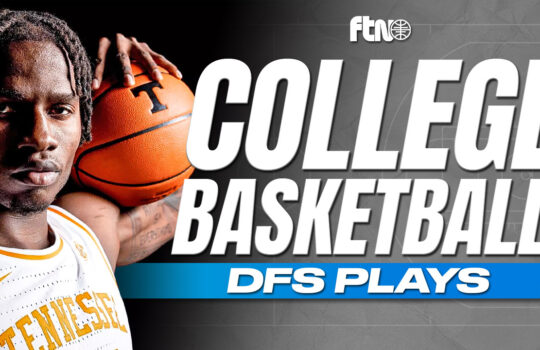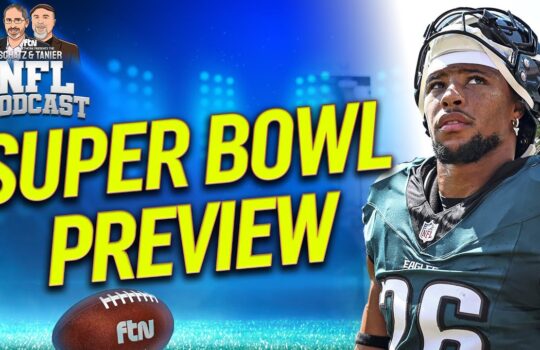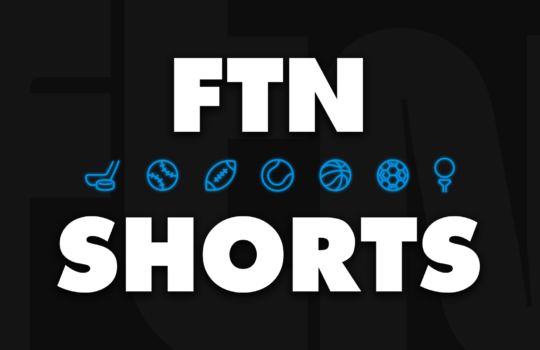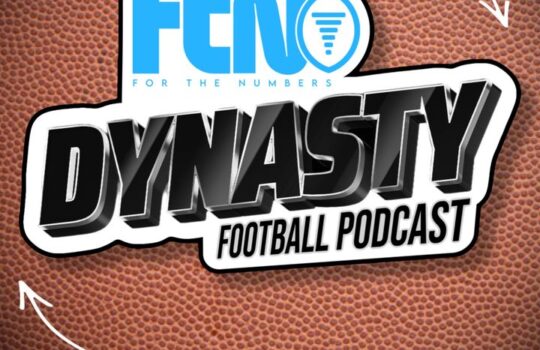
Jared Goff just signed a four-year, $212-million extension with the Lions, keeping him in Detroit through the height of their Super Bowl window. It’s a lot of money, making him the second-highest paid quarterback in the NFL, but Goff is the first quarterback in Lions history to have multiple seasons above a 20% DVOA, and it’s not like there are much better quarterbacks easily available, so the move makes sense.
As part of the reporting of the deal, Next Gen Stats put out a graphic about the best passers against the blitz, noting that Goff led the league with 1,623 yards, and was only sacked on 4.3% of his dropbacks against the blitz. Goff’s grace under pressure was responsible for the Lions’ success … right?
It’s time for our annual dive into our data as we rev up for this year’s FTN Football Almanac. This month, we’re focusing on pressure, starting with quarterbacks. Who faced pressure the most often, who failed or succeeded from clean pocket, and who played best and worst under pressure?
Let’s start with the data itself. The following table shows pressure numbers for all quarterbacks with at least 200 pass plays in 2023. Quarterbacks are ranked from lowest pressure rate (Joe Flacco, 19.8%) to highest (Justin Fields, 41.1%).
| Quarterbacks and Pressure, 2023 | |||||||||
| QB | Team | Plays | Pct Press | Yds w/Press | DVOA w/Press | Yds No Press | DVOA no Press | Yds Dif. | DVOA Dif. |
| Justin Fields | CHI | 457 | 41.1% | 2.5 | -64.7% | 8.0 | 42.3% | -5.4 | -107.0% |
| Russell Wilson | DEN | 523 | 40.3% | 3.5 | -45.8% | 7.5 | 39.0% | -4.0 | -84.8% |
| Will Levis | TEN | 290 | 36.2% | 1.9 | -107.1% | 8.0 | 64.1% | -6.2 | -171.1% |
| Ryan Tannehill | TEN | 268 | 36.2% | 0.6 | -113.4% | 8.2 | 54.6% | -7.6 | -167.9% |
| Tommy DeVito | NYG | 237 | 35.0% | -0.6 | -132.5% | 6.9 | 26.5% | -7.5 | -159.0% |
| Zach Wilson | NYJ | 436 | 34.4% | 0.8 | -113.7% | 7.1 | 36.3% | -6.4 | -150.0% |
| Kenny Pickett | PIT | 360 | 33.6% | 2.7 | -65.0% | 6.8 | 36.6% | -4.1 | -101.6% |
| Kirk Cousins | MIN | 328 | 33.5% | 4.6 | -30.0% | 7.9 | 39.0% | -3.3 | -69.0% |
| Joshua Dobbs | 2TM | 481 | 33.1% | 2.8 | -61.9% | 6.3 | 21.8% | -3.5 | -83.7% |
| Geno Smith | SEA | 546 | 33.0% | 2.7 | -44.6% | 8.3 | 56.3% | -5.6 | -100.9% |
| Bryce Young | CAR | 619 | 33.0% | 1.0 | -115.9% | 5.9 | 5.5% | -4.9 | -121.3% |
| Sam Howell | WAS | 709 | 32.2% | 2.8 | -90.8% | 6.4 | 23.0% | -3.7 | -113.8% |
| Brock Purdy | SF | 486 | 31.3% | 5.3 | -23.7% | 10.3 | 99.0% | -5.1 | -122.7% |
| Lamar Jackson | BAL | 559 | 31.1% | 4.2 | -41.0% | 8.1 | 60.5% | -3.8 | -101.5% |
| Justin Herbert | LAC | 516 | 30.2% | 2.9 | -68.0% | 7.4 | 59.3% | -4.6 | -127.3% |
| Jalen Hurts | PHI | 622 | 30.2% | 3.9 | -47.7% | 7.4 | 52.7% | -3.5 | -100.4% |
| Bailey Zappe | NE | 246 | 29.7% | 2.3 | -87.1% | 5.7 | -3.9% | -3.4 | -83.2% |
| C.J. Stroud | HOU | 554 | 28.5% | 2.1 | -82.5% | 9.0 | 75.3% | -6.9 | -157.8% |
| Patrick Mahomes | KC | 672 | 28.4% | 3.9 | -35.8% | 7.6 | 50.2% | -3.7 | -86.0% |
| QB | Team | Plays | Pct Press | Yds w/Press | DVOA w/Press | Yds No Press | DVOA no Press | Yds Dif. | DVOA Dif. |
| Josh Allen | BUF | 649 | 28.0% | 3.9 | -28.9% | 8.1 | 65.0% | -4.3 | -93.9% |
| Matthew Stafford | LAR | 562 | 27.9% | 3.0 | -50.3% | 8.2 | 53.7% | -5.2 | -104.0% |
| Gardner Minshew | IND | 545 | 27.7% | 3.3 | -57.9% | 7.0 | 32.4% | -3.7 | -90.3% |
| Jake Browning | CIN | 283 | 27.6% | 1.5 | -83.9% | 8.5 | 73.5% | -7.0 | -157.4% |
| Baker Mayfield | TB | 636 | 26.7% | 3.1 | -52.3% | 7.4 | 38.8% | -4.4 | -91.1% |
| Jared Goff | DET | 637 | 26.5% | 3.2 | -73.0% | 8.2 | 60.4% | -5.0 | -133.4% |
| Joe Burrow | CIN | 402 | 26.4% | 2.2 | -53.3% | 6.7 | 35.6% | -4.6 | -88.9% |
| Desmond Ridder | ATL | 436 | 25.9% | 2.9 | -67.3% | 7.5 | 25.0% | -4.6 | -92.3% |
| Dak Prescott | DAL | 656 | 25.9% | 5.0 | -33.0% | 7.4 | 40.6% | -2.4 | -73.5% |
| Mac Jones | NE | 379 | 25.9% | 2.8 | -77.0% | 6.4 | 14.0% | -3.6 | -91.0% |
| Derek Carr | NO | 588 | 25.0% | 2.6 | -74.8% | 7.5 | 39.6% | -4.8 | -114.4% |
| Trevor Lawrence | JAX | 640 | 23.1% | 3.4 | -60.5% | 7.3 | 39.3% | -3.9 | -99.8% |
| Aidan O’Connell | LV | 366 | 23.0% | 0.8 | -114.7% | 7.0 | 34.8% | -6.1 | -149.4% |
| Jordan Love | GB | 631 | 22.2% | 2.3 | -70.4% | 7.7 | 54.7% | -5.5 | -125.1% |
| Kyler Murray | ARI | 301 | 21.9% | 1.7 | -87.0% | 7.3 | 38.4% | -5.6 | -125.4% |
| Tua Tagovailoa | MIA | 603 | 21.7% | 2.6 | -55.4% | 8.9 | 69.6% | -6.3 | -124.9% |
| Joe Flacco | CLE | 212 | 19.8% | 4.4 | -68.6% | 8.0 | 46.7% | -3.6 | -115.3% |
We should note here that all DVOAs in this article are technically team DVOA rather than individual passer DVOA (because they include scrambles) so the average will be higher than 0% because running plays and false starts are not included.
Jared Goff, Tip Your Linemen
We’ll start with Goff because he just got the oversized novelty check. In a clean pocket, Goff’s 60.4% DVOA was eighth in the league, in the same neighborhood as Josh Allen and Lamar Jackson. When pressured, however, that fell all the way to -73.0%, which ranked 23rd and had him finish just ahead of Derek Carr and Mac Jones. That -133.4% drop was the eighth largest in the league, and the worst for anyone you could consider an established veteran starter; everyone above him was either very young, a backup, benched, or some combination of the three.
Goff has never been ideal under pressure. While DVOA under pressure is less stable year-to-year than clean pocket DVOA, Goff routinely ranks somewhere in the 20s. In his eight years in the league, he’s only been in the top 10 in pressured DVOA one time, and the top 20 just twice. There are worse players under pressure, and Goff’s ability to run the offense when things are going well is a major plus. We’re not trying to say that signing Goff to a long-term deal is a terrible move by Detroit or anything of that nature. But Goff needs more help from his offensive line than other quarterbacks in his new tax bracket.
What you’re seeing in those Next Gen numbers against the blitz is less a credit to Goff, and more a credit to Penei Sewell, Frank Ragnow and the rest of Detroit’s offensive line. Goff was one of the most-blitzed quarterbacks in football in 2023, in large part because opposing defensive coordinators know he is not the best when pressured. He faced five or more pass rushers on 33% of his dropbacks; only Kirk Cousins and Gardner Minshew were blitzed more. And yet, pressure only got home on 30% of those blitzes, as Detroit’s pass protection held up under fire better than almost any other offensive line in the league. That left a lot of dropbacks where Goff was facing defenses that had committed extra men to the blitz but just did not get home, leaving someone in clear one-on-one coverage somewhere. That’s why he led the league in passing yards against the blitz; he was really the league leading in passing yards against ineffective blitzes. Goff had 1,112 passing yards against blitzes that did not result in pressure, just ahead of Love (1,024) and Lamar Jackson (1,015). That’s a skill, for sure – punish the defense for their failures – but significant credit needs to his protection first and foremost.
As for the other four players in that Next Gen top five with Goff, Jordan Love is in much the same boat – he was only pressured on 28% of plays with 5+ blitzers, second best in the league and only behind Joe Flacco’s small sample size. Love fell from 11th with no pressure to 22nd with it; that’s not entirely unexpected from a quarterback with limited experience, but it’s an area where he has room for improvement. Brock Purdy and Dak Prescott were pressured 35% of the time they saw blitzes, ranking 15th and 16th. Josh Allen, meanwhile, saw pressure get home on 40% of plays with 5+ blitzers and 65% of plays with six or more – he wasn’t blitzed much, but defenses made him work for it when they did.
By FTN Data charting, the actual top five yardage totals while under pressure, as opposed to just being blitzed, would have been:
1. Dak Prescott (1,029)
2. Sam Howell (917)
3. Russell Wilson (889)
4. Brock Purdy (877)
5. Patrick Mahomes (814)
Goff would have ranked a respectable eighth with 749 yards, but he also threw seven interceptions when pressured. The only passer with more in 2023 was Sam Howell, with 14. Goff is good, and in years where he has an effective offensive line, routinely hits the top five in DYAR and DVOA. It’s just a good thing that Detroit has also invested in help up front, because Goff is fairly reliant on clean pockets to get to work.
The Obligatory Brock Purdy Section
Yes, it’s an article looking at quarterback statistics from the 2023 NFL season, so we have to spend some time talking about Brock Purdy. Welcome to Purdgatory.
Purdy led the league in DVOA when pressured, with a DVOA of -23.7%. Purdy led the league in DVOA when not pressured, with a DVOA of 99.0%. He’s the first player to lead the league in both categories since Patrick Mahomes in 2018. He had the second-best DVOA under pressure of the last five years, just behind 2020 Dak Prescott’s -22.2% in the pandemic season. His DVOA without pressure is the best we’ve recorded since at least 2017, though we can’t compare exact DVOAs that far back because of different data providers which means different definitions for pressure. And while yes, his YAC helped him out some, he also had the third-largest aDOT on completions both with and without pressure.
Purdy’s performance under pressure is the thing that most differentiates him from his predecessor Jimmy Garoppolo. The last time we wrote this article, the lede was about why the 49ers had decided to move on from Jimmy G for the enticing Trey Lance – the fact that his performance consistently nosedived when opposing pass-rushers got pressure on him. In Garoppolo’s three qualified seasons in San Francisco, he finished eighth, third and second in DVOA in clean pockets. But when pressured, that fell to 29th, 23rd and 31st. Had he qualified for the main leaderboards this year, he would have been 28th with a -85.6% DVOA under pressure. Garoppolo has simply never managed to handle a pass rusher in his face – a more extreme version of Goff’s splits.
Purdy didn’t qualify for the leaderboards as a rookie, but his -41.0% DVOA when pressured would have been third in the league in 2022. He certainly was better this season – his yards per play jumped up by more than two yards – but his relative calm under pressure wasn’t new. No one is going to mistake him for Lamar Jackson when a play breaks down, but he has repeatedly demonstrated the ability to extend plays where Garoppolo would have flailed. Purdy had 39 first downs or touchdowns on pressure plays last season, more than Garoppolo had in 2021 and 2022 combined. Purdy had a sack rate of 18.1% and an interception rate of 2.6% under pressure; Garoppolo’s best marks in a qualified season were 23.9% and 2.9%, and he averaged 25% and 4.0%.
You can make an argument that Purdy has not increased San Francisco’s ceiling; that when the offense is clicking, Purdy is no better than Garoppolo at running it and anyone with an NFL-caliber resume could step in and look like a star. The data doesn’t fully back that up, as Purdy’s clean pocket DVOA is better than anything Garoppolo or the assorted backups ever put up under Shanahan, but it’s close enough that you can talk about personnel and sample sizes and make a case. But there’s very little doubt that Purdy has significantly increased the floor of the 49ers’ offense due to how he’s managed to handle pressure through a season and a half of work.
Rookies Under Pressure
C.J. Stroud and Bryce Young had very different seasons – this is the sort of in-depth analysis you’ve come to expect from the experts here at FTN. You can see that reflected in the non-pressured DVOA numbers: Stroud finished second behind Purdy at 75.3%, while Young was second worst ahead of Bailey Zappe at 5.5%. In the best possible circumstances, when the rest of the offense was doing its job and giving the quarterback time, Stroud looked like a Pro Bowler and future star while Young looked like he had been introduced to the concept of football approximately 10 minutes before kickoff.
But the gap between the two shrunk significantly when under pressure. Young, once again, was second worst at -115.9%, only ahead of Tommy DeVito. But Stroud fell from second to 26th when opposing defenses got home, with a -82.5% DVOA placing him just under Mac Jones. Stroud fell -157.8% under pressure, the fourth-largest drop in the league. That’s still a significant advantage for Stroud, but it’s an entirely different scale. Had the two rookies finished 26th and 35th in total passing DVOA, Carolina fans wouldn’t feel quite so much like they missed out.
Young led the league with 33 throwaways under pressure; Jalen Hurts was next with 28. That might have been the most frustrating part of watching Young’s rookie season: the sheer number of throws where the Carolina offense just gave up. Some of that comes from a lack of trust in his receivers, for sure, but a lot of these throwaways came very early in the play. It was like there was a switch in Young’s brain; as soon as the slightest whiff of pressure came, Young was looking to give up and move on to the next play. It wasn’t just a counting stat, either, an artifact of Carolina allowing over 200 pressured snaps. Young’s 16.2% throwaway rate under pressure was worst in the league. No one else hit 15%. Young also had only a 61% success rate on his completions when under pressure, fifth worst in the league; and his sack percentage of 30.4% was sixth worst. Carolina’s lack of talent around Young meant the rookie rarely had the chance to do anything when things went south, but Young also wasn’t exactly giving his supporting cast much of a chance to try to make things happen. It’s an absolute mess, and Dave Canales has his work cut out for him.
Stroud wasn’t great under pressure at Ohio State and early returns have him not immediately solving those issues in the NFL. In many ways, he had the opposite problem to Young. When Stroud’s first few reads fail to work, he tends to hold on to the ball and try to will something to happen. He was fifth in the league with an average time to throw over three seconds, an average that only goes up when the play breaks down. He had a 23.9% sack rate under pressure – still better than Young, of course, but just 25th in the league. Those sacks came an average of 8.7 yards behind the line of scrimmage, worst in the NFL – there were quite a few where Stroud dropped back, got in trouble, kept dropping back, and eventually was brought down. This is why Stroud lost more yards on sacks than guys like Russell Wilson and Justin Fields; your typical Stroud sack came much further behind the line. Overly trusting your arm is far from the worst sin a rookie quarterback can have. But it’s an area where Stroud can improve on his already impressive rookie season – learning when to checkdown or find the hot read or just throw the ball away under pressure.
Odds and Ends
Following Purdy on the best under pressure chart were Josh Allen, Kirk Cousins, Dak Prescott and Patrick Mahomes, in perhaps the easiest game of “one of these things is not like the others” In history. Cousins has finished in the top 10 in pressure DVOA in each of the last two seasons, so he’s shown he can handle someone breathing down his neck, be it a blitzing linebacker or a first-round backup.
Cousins and Prescott finished 1-2 with the smallest difference between their DVOA with and without pressure, at -69.0% and -73.5%, respectively. That sounds like a compliment, until you realize it means they were both quite middling in clean pockets, finishing 21st and 18th. It may say something about their respective offenses that they weren’t that much worse when things went wrong.
Bailey Zappe had the worst DVOA without pressure, clocking in at a dismal -3.9%. Yes, the Patriots offense was below average when Zappe was throwing the ball without a pass rusher in his face. That’s impressive; the only other quarterback to manage that feat in the past five years was Dwayne Haskins. It’s not all Zappe’s fault, mind you, as Mac Jones was third worst at 14.0%, sandwiching Bryce Young at the bottom of the leaderboard. The Patriots offense was really not fun to watch last year, was it?
Speaking of not fun to watch, Tommy DeVito averaged -0.6 yards per play when pressured. Remember, an incomplete pass or an interception gets you 0, so you – yes, you, reading this article right now – could have given the Giants more yards under duress than DeVito did simply by spiking the ball at Saquon Barkley’s feet every snap. You’d have a better DVOA, too; the league had a DVOA of about -110% on incomplete passes, while DeVito clocked in at -132.5%. Also arguably worse than simply throwing the ball away every snap: Bryce Young (-115.9%), Aidan O’Connell (-114.7%), Zach Wilson (-113.7%) and Ryan Tannehill (-113.4%).
DeVito had the third-biggest difference in his DVOA with and without pressure, dropping 159.0% and falling from 30th to 36th. The only players who fell further were Will Levis and Ryan Tannehill, who had near-identical efficiencies both with and without pressure.
Behind Purdy and Stroud on the best without pressure chart were Jake Browning, Tua Tagovailoa and Josh Allen. Browning dropped nearly as far as Stroud did with pressure, going from a 73.5% DVOA to an -83.9% in his partial season. Expectations are a little different for the second overall pick and a journeyman undrafted backup; the fact that Browning looked good when given clean opportunities is fantastic for him.
We don’t know what Russell Wilson and Justin Fields will talk about while battling for the Steelers’ starting quarterback job, but perhaps they can bond over working behind lines made of Swiss cheese. They were the only two players to have a pressure rate of over 40% last season – partially their faults for holding on to the ball forever, but also not amazing reviews of the Bears and Broncos offensive lines. Behind them were Will Levis and Ryan Tannehill. Levis had a pressure rate of 36.21%, Tannehill one of 36.19%. Clearly, the line respected Tannehill more and blocked better for him; let’s get that take on talk radio right away.
The least pressured quarterbacks in football were Joe Flacco (19.8%), followed by Tua Tagovailoa, Kyler Murray, Jordan Love and Aidan O’Connell. Of the five, O’Connell needed the help the most, averaging just 0.8 yards per play when protection broke down. Tagovailoa makes this list by having the league’s quickest time to throw; there often wasn’t time for pressure to develop. Flacco and Love both have great offensive lines to thank. And Murray? Well, the Cardinals’ offensive line situation was interesting, and we’ll dive more into that in a couple weeks when we introduce “caused pressure rate”.

















































 New York Jets
New York Jets  New England Patriots
New England Patriots  Miami Dolphins
Miami Dolphins  Buffalo Bills
Buffalo Bills  Pittsburgh Steelers
Pittsburgh Steelers  Cleveland Browns
Cleveland Browns  Cincinnati Bengals
Cincinnati Bengals  Baltimore Ravens
Baltimore Ravens  Tennessee Titans
Tennessee Titans  Jacksonville Jaguars
Jacksonville Jaguars  Indianapolis Colts
Indianapolis Colts  Houston Texans
Houston Texans  Las Vegas Raiders
Las Vegas Raiders  Los Angeles Chargers
Los Angeles Chargers  Kansas City Chiefs
Kansas City Chiefs  Denver Broncos
Denver Broncos  Washington Commanders
Washington Commanders  Philadelphia Eagles
Philadelphia Eagles  New York Giants
New York Giants  Dallas Cowboys
Dallas Cowboys  Minnesota Vikings
Minnesota Vikings  Green Bay Packers
Green Bay Packers  Detroit Lions
Detroit Lions  Chicago Bears
Chicago Bears  Tampa Bay Buccaneers
Tampa Bay Buccaneers  New Orleans Saints
New Orleans Saints  Carolina Panthers
Carolina Panthers  Atlanta Falcons
Atlanta Falcons  San Francisco 49ers
San Francisco 49ers  Seattle Seahawks
Seattle Seahawks  Los Angeles Rams
Los Angeles Rams  Arizona Cardinals
Arizona Cardinals 





 Boston Celtics
Boston Celtics  Brooklyn Nets
Brooklyn Nets  Philadelphia 76ers
Philadelphia 76ers  New York Knicks
New York Knicks  Toronto Raptors
Toronto Raptors  Chicago Bulls
Chicago Bulls  Detroit Pistons
Detroit Pistons  Milwaukee Bucks
Milwaukee Bucks  Cleveland Cavaliers
Cleveland Cavaliers  Indiana Pacers
Indiana Pacers  Orlando Magic
Orlando Magic  Atlanta Hawks
Atlanta Hawks  Charlotte Hornets
Charlotte Hornets  Miami Heat
Miami Heat  Washington Wizards
Washington Wizards  Denver Nuggets
Denver Nuggets  Minnesota Timberwolves
Minnesota Timberwolves  Oklahoma City Thunder
Oklahoma City Thunder  Portland Trail Blazers
Portland Trail Blazers  Utah Jazz
Utah Jazz  LA Clippers
LA Clippers  Golden State Warriors
Golden State Warriors  Los Angeles Lakers
Los Angeles Lakers  Phoenix Suns
Phoenix Suns  Sacramento Kings
Sacramento Kings  Dallas Mavericks
Dallas Mavericks  Houston Rockets
Houston Rockets  Memphis Grizzlies
Memphis Grizzlies  New Orleans Pelicans
New Orleans Pelicans  San Antonio Spurs
San Antonio Spurs 










